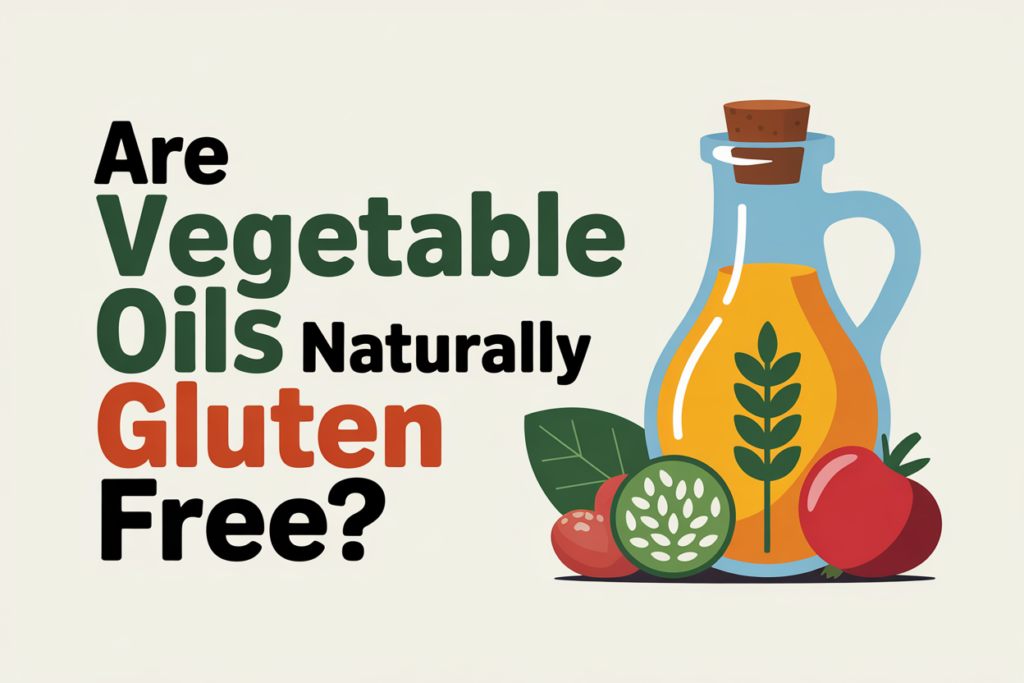Yes, vegetable oil is gluten free in its pure form. Most vegetable oils—like soybean, canola, sunflower, and olive oil—don’t contain gluten. However, always check labels to avoid cross-contamination or added flavorings that may introduce gluten.
Whether you’re cooking at home or scanning store shelves for safe ingredients, wondering if vegetable oil is gluten free is a common concern—especially if you or a loved one has celiac disease or gluten sensitivity. With so many brands, blends, and labels, it can be confusing to know what’s truly safe.
The good news? You’re in the right place. This guide explains exactly which oils are naturally gluten free, how to spot hidden gluten risks, and which trusted brands you can use with confidence. Let’s walk through everything you need to know, step by step.
Contents
- 1 What is Gluten and Why Does it Matter?
- 2 Are Vegetable Oils Naturally Gluten Free?
- 3 Gluten-Free Safe Oils List (USA Market)
- 4 Cross-Contamination Risks in Oil Processing
- 5 How to Minimize the Risk
- 6 FDA Guidelines on Gluten-Free Labeling
- 7 Best Practices for Cooking Gluten-Free with Oil
- 8 FAQs About Vegetable Oil and Gluten
- 9 Final Thoughts: Choosing the Right Oil for a Gluten-Free Diet
What is Gluten and Why Does it Matter?
Understanding Gluten
Gluten is a type of protein found in grains like wheat, barley, and rye. It helps food hold its shape, especially in bread and baked goods. But for people with celiac disease or gluten sensitivity, gluten can cause serious health problems. Even tiny amounts may trigger bloating, headaches, or damage to the small intestine.
People with celiac disease must avoid all sources of gluten. This includes hidden sources in processed foods, sauces, and sometimes even oils. According to the Celiac Disease Foundation, gluten-free living is the only treatment for those with the condition.
Why Gluten-Free Matters in Cooking Oils
You might not expect oils to be a gluten risk, but they can be. While pure oils are made from seeds or vegetables and don’t naturally have gluten, cross-contact during manufacturing is a real concern. For example, oils made on the same lines as flavored or breaded items might pick up traces of gluten.
If you’re cooking for someone who is gluten-free, it’s not enough to assume an oil is safe. Always read labels and look for products that say “gluten-free certified”. These have been tested and follow the U.S. FDA gluten-free labeling rules.
Are Vegetable Oils Naturally Gluten Free?

Base Ingredients of Vegetable Oil
Vegetable oil is not made from one plant. It’s often a blend of several plant-based oils. The most common ones include:
- Soybean oil
- Canola oil
- Corn oil
- Sunflower oil
- Palm oil
These oils come from plants that do not contain gluten. The oil is pressed or extracted from the seeds and then refined. This process removes proteins, including gluten, making the final oil gluten free in its pure state.
The Answer: Is Vegetable Oil Gluten Free?
Yes, vegetable oil is gluten free—if it’s pure and not mixed with gluten-containing ingredients. However, there are two things to watch for:
- Blended or flavored oils: These might include spice blends or additives with gluten.
- Shared equipment: If the oil is processed in a facility that also handles wheat, it could be cross-contaminated.
To stay safe, always choose oils with clear labels. Many brands in the USA now offer oils that are certified gluten free, making shopping easier for those on a strict diet. Look for seals from trusted organizations like the Gluten-Free Certification Organization (GFCO).
Gluten-Free Safe Oils List (USA Market)
Certified Gluten-Free Oils
Here’s a list of popular oils that are certified gluten free and widely available in the United States:
| Brand | Type of Oil | Gluten-Free Certified? |
|---|---|---|
| Crisco | Pure Canola, Vegetable | Yes |
| Wesson | Canola, Corn, Soybean | Yes |
| Spectrum Organic | Olive, Canola, Sunflower | Yes |
| Pompeian | Olive, Grapeseed | Yes |
| La Tourangelle | Avocado, Walnut | Yes |
These brands follow strict guidelines to avoid cross-contamination. They’re safe choices for anyone needing a gluten-free diet.
Popular Gluten-Free Oils for Cooking & Baking
Besides certified brands, many natural oils are safe. These include:
- Olive oil: Great for salads and sautéing.
- Avocado oil: High smoke point; good for grilling.
- Coconut oil: Perfect for baking.
- Sunflower oil: Light flavor; ideal for frying.
- Grapeseed oil: Good for medium-heat cooking.
These oils are naturally gluten free and work well in many recipes. If you’re buying a new bottle, it’s still smart to double-check the label.
Oils to Be Cautious Of
Some oils seem safe but may hide gluten in flavors or processing methods. Be careful with:
- Infused oils (like garlic or chili oil)
- Flavored oils (butter or herb blends)
- Generic oil blends with unclear labeling
These can sometimes include additives or be processed in shared facilities. Always check for a gluten-free label or contact the brand if unsure. Even tiny gluten amounts can cause symptoms for sensitive individuals.
Cross-Contamination Risks in Oil Processing
How Cross-Contamination Happens
Even though most vegetable oils start off gluten free, cross-contamination during processing can be a problem. This happens when oil is made or bottled in a factory that also handles gluten. If machines aren’t cleaned well between batches, small traces of gluten can get into the oil. That’s enough to cause symptoms for people with celiac disease or gluten sensitivity.
One common example is shared equipment. If the same line makes flavored oils that use wheat-based seasonings, it may also be used for regular vegetable oil. Another example is storage containers that aren’t sealed tightly and get exposed to airborne gluten particles. While rare, these risks still matter to those on a strict gluten-free diet.
According to Beyond Celiac, cross-contact is one of the biggest hidden dangers in a gluten-free lifestyle. That’s why certified oils are the safest option.
How to Minimize the Risk
FDA Guidelines on Gluten-Free Labeling
The U.S. Food and Drug Administration (FDA) has a strict rule for anything labeled “gluten free.” It must contain less than 20 parts per million (ppm) of gluten. This is the lowest amount that can be reliably measured in food. It’s also the threshold considered safe for people with celiac disease.
For oils, this means that any product labeled “gluten free” must meet this limit. It also can’t be made with gluten grains or be cross-contaminated during processing. The label is voluntary, but if it’s used, the product must follow these rules.
The FDA explains its rule clearly in this official guide. When you see “gluten free” on a bottle of oil, it gives you peace of mind that it’s been reviewed and meets the safety standard.
But some oils don’t carry the label—even if they’re safe. That’s why it’s smart to learn about trusted brands and read ingredient lists closely.
Best Practices for Cooking Gluten-Free with Oil
Safe Cooking Tips
Using gluten-free oil is just the first step. How you cook and serve it also matters. Even a clean oil can become unsafe if it touches something with gluten. Here are some simple tips:
- Use clean cookware. Don’t use pans that were used to fry gluten foods unless they’ve been washed with soap and hot water.
- Use separate utensils. Keep a dedicated spatula or spoon for gluten-free meals.
- Store oil safely. Keep your gluten-free oil in a sealed bottle away from flour or breaded foods.
- Don’t dip or double dip. Avoid dipping gluten-covered food into shared oil.
If you’re deep frying, it’s safest to use fresh oil every time. Reusing oil after frying breaded chicken or battered foods increases the risk of gluten transfer.
Baking & Frying Considerations
Not all oils work the same way. Some are better for baking, while others are better for high heat. Here’s a simple guide:
| Oil Type | Best Use | Smoke Point (°F) |
|---|---|---|
| Olive Oil | Sautéing, roasting | 375–410 |
| Canola Oil | Baking, frying | 400 |
| Avocado Oil | High-heat cooking | 520 |
| Coconut Oil | Baking, light frying | 350 |
| Sunflower Oil | Frying, roasting | 450 |
Choosing the right oil helps you get the best taste and texture. It also helps you cook safely if you’re avoiding gluten.
For deeper learning about safe cooking at home, visit Gluten Intolerance Group — they offer great tips on keeping your kitchen gluten free.
FAQs About Vegetable Oil and Gluten
Is canola oil gluten free?
Yes. Canola oil is naturally gluten free. It comes from the canola plant, which is not related to wheat or barley. Most refined canola oils are safe. Still, check the label to be sure it’s not flavored or processed in a facility with gluten.
Can vegetable oil cause a gluten reaction?
Only if it’s cross-contaminated. Pure vegetable oil won’t cause a gluten reaction. But if it was processed on shared lines with products that contain gluten, small amounts may be present. That’s why it’s best to buy oils that are labeled gluten free or made in dedicated facilities.
Are cold-pressed oils safer?
Not always. Cold-pressed oils are less refined, so more of the plant’s natural parts may remain. These oils are usually safe, but they don’t go through processes that might remove any gluten traces. If the seeds were clean and not exposed to gluten, cold-pressed oils are fine. But if you’re very sensitive, choose a refined oil with certification for extra safety. You can learn more about cold-pressed vs refined oils from Harvard Health.
Is reused oil gluten safe?
No. Once oil has been used to cook breaded or gluten-coated foods, it’s no longer safe. Gluten particles can remain in the oil. When reused, these can stick to otherwise gluten-free foods. Always use fresh oil for gluten-free cooking to avoid this risk.
Final Thoughts: Choosing the Right Oil for a Gluten-Free Diet
Finding the right oil isn’t just about flavor. It’s about safety, too. Most vegetable oils are naturally gluten free, but that doesn’t mean every bottle is risk-free. Always read labels, avoid flavored or mixed oils without clear ingredient lists, and look for trusted brands.
Stick with certified oils if you or your family must follow a strict gluten-free diet. This helps you skip the guesswork. Whether you’re baking a cake, frying chicken, or tossing a salad, your choice of oil can make a big difference.
If you’re ever unsure, reach out to the company. Many brands have great customer support and will confirm if their product is safe for gluten-free cooking. You can also find reliable information through groups like the Celiac Disease Foundation and Gluten Free Watchdog.
With a little attention to detail, you can cook delicious, safe meals using oils that fit perfectly into your gluten-free lifestyle.

